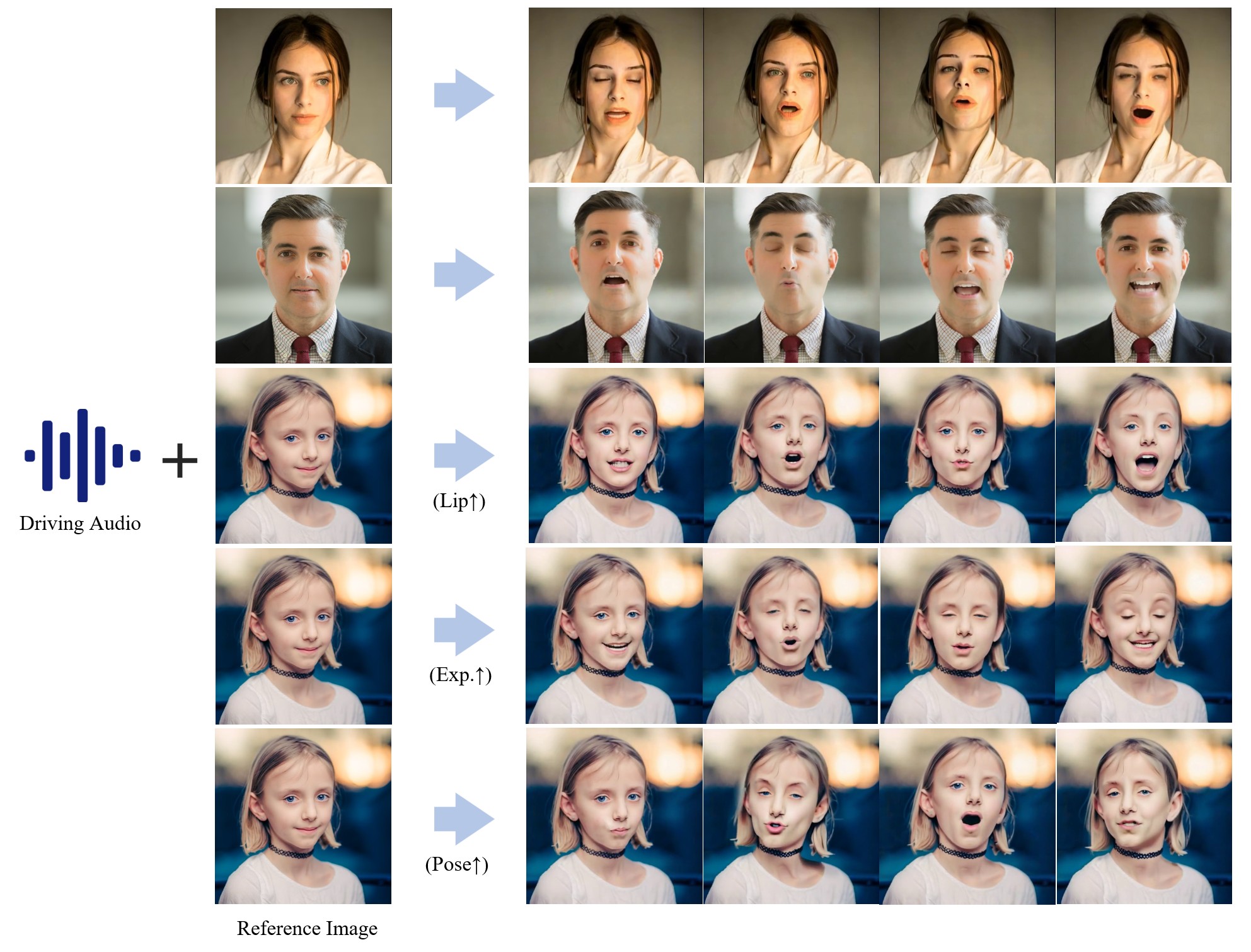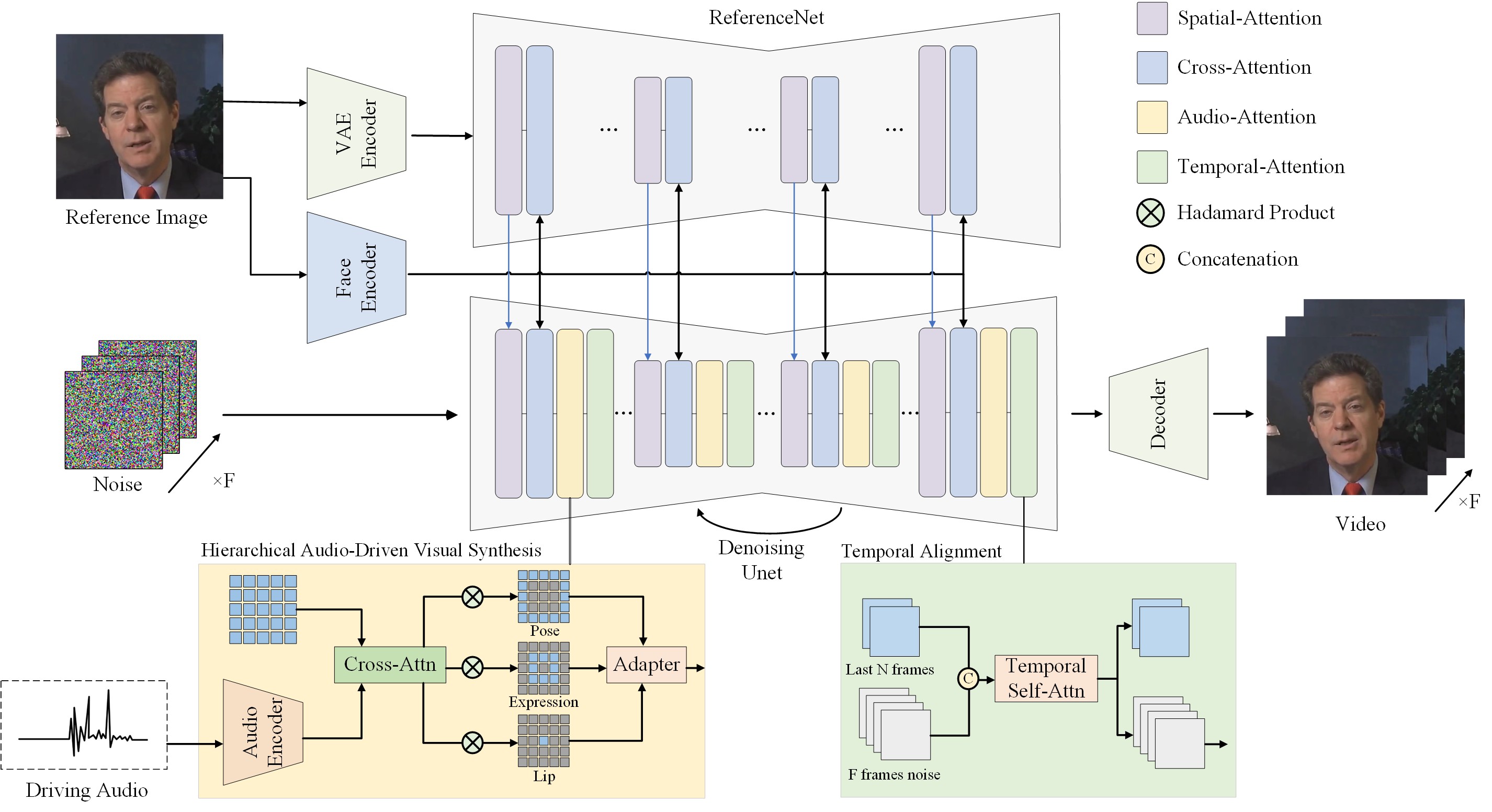Spaces:
Sleeping
A newer version of the Gradio SDK is available:
4.37.2
title: Hallo
emoji: 👋
sdk: gradio
sdk_version: 4.36.1
app_file: app.py
pinned: false
suggested_hardware: l4x1
short_description: Generate realistic talking heads from image+audio
Hallo: Hierarchical Audio-Driven Visual Synthesis for Portrait Image Animation
Showcase
Framework
News
2024/06/15: 🎉🎉🎉 Release the first version on GitHub.2024/06/15: ✨✨✨ Release some images and audios for inference testing on Huggingface.
Installation
- System requirement: Ubuntu 20.04/Ubuntu 22.04, Cuda 12.1
- Tested GPUs: A100
Create conda environment:
conda create -n hallo python=3.10
conda activate hallo
Install packages with pip
pip install -r requirements.txt
pip install .
Besides, ffmpeg is also need:
apt-get install ffmpeg
Inference
The inference entrypoint script is scripts/inference.py. Before testing your cases, there are two preparations need to be completed:
Download pretrained models
You can easily get all pretrained models required by inference from our HuggingFace repo.
Clone the the pretrained models into ${PROJECT_ROOT}/pretrained_models directory by cmd below:
git lfs install
git clone https://huggingface.co/fudan-generative-ai/hallo pretrained_models
Or you can download them separately from their source repo:
- hallo: Our checkpoints consist of denoising UNet, face locator, image & audio proj.
- audio_separator: Kim_Vocal_2 MDX-Net vocal removal model by KimberleyJensen. (Thanks to runwayml)
- insightface: 2D and 3D Face Analysis placed into
pretrained_models/face_analysis/models/. (Thanks to deepinsight) - face landmarker: Face detection & mesh model from mediapipe placed into
pretrained_models/face_analysis/models. - motion module: motion module from AnimateDiff. (Thanks to guoyww).
- sd-vae-ft-mse: Weights are intended to be used with the diffusers library. (Thanks to stablilityai)
- StableDiffusion V1.5: Initialized and fine-tuned from Stable-Diffusion-v1-2. (Thanks to runwayml)
- wav2vec: wav audio to vector model from Facebook.
Finally, these pretrained models should be organized as follows:
./pretrained_models/
|-- audio_separator/
| `-- Kim_Vocal_2.onnx
|-- face_analysis/
| `-- models/
| |-- face_landmarker_v2_with_blendshapes.task # face landmarker model from mediapipe
| |-- 1k3d68.onnx
| |-- 2d106det.onnx
| |-- genderage.onnx
| |-- glintr100.onnx
| `-- scrfd_10g_bnkps.onnx
|-- motion_module/
| `-- mm_sd_v15_v2.ckpt
|-- sd-vae-ft-mse/
| |-- config.json
| `-- diffusion_pytorch_model.safetensors
|-- stable-diffusion-v1-5/
| |-- feature_extractor/
| | `-- preprocessor_config.json
| |-- model_index.json
| |-- unet/
| | |-- config.json
| | `-- diffusion_pytorch_model.safetensors
| `-- v1-inference.yaml
`-- wav2vec/
|-- wav2vec2-base-960h/
| |-- config.json
| |-- feature_extractor_config.json
| |-- model.safetensors
| |-- preprocessor_config.json
| |-- special_tokens_map.json
| |-- tokenizer_config.json
| `-- vocab.json
Run inference
Simply to run the scripts/inference.py and pass source_image and driving_audio as input:
python scripts/inference.py --source_image your_image.png --driving_audio your_audio.wav
Animation results will be saved as ${PROJECT_ROOT}/.cache/output.mp4 by default. You can pass --output to specify the output file name.
For more options:
usage: inference.py [-h] [-c CONFIG] [--source_image SOURCE_IMAGE] [--driving_audio DRIVING_AUDIO] [--output OUTPUT] [--pose_weight POSE_WEIGHT]
[--face_weight FACE_WEIGHT] [--lip_weight LIP_WEIGHT] [--face_expand_ratio FACE_EXPAND_RATIO]
options:
-h, --help show this help message and exit
-c CONFIG, --config CONFIG
--source_image SOURCE_IMAGE
source image
--driving_audio DRIVING_AUDIO
driving audio
--output OUTPUT output video file name
--pose_weight POSE_WEIGHT
weight of pose
--face_weight FACE_WEIGHT
weight of face
--lip_weight LIP_WEIGHT
weight of lip
--face_expand_ratio FACE_EXPAND_RATIO
face region
Roadmap
| Status | Milestone | ETA |
|---|---|---|
| ✅ | Inference source code meet everyone on GitHub | 2024-06-15 |
| ✅ | Pretrained models on Huggingface | 2024-06-15 |
| 🚀🚀🚀 | Traning: data preparation and training scripts | 2024-06-25 |
Citation
If you find our work useful for your research, please consider citing the paper:
@misc{xu2024hallo,
title={Hallo: Hierarchical Audio-Driven Visual Synthesis for Portrait Image Animation},
author={Mingwang Xu and Hui Li and Qingkun Su and Hanlin Shang and Liwei Zhang and Ce Liu and Jingdong Wang and Yao Yao and Siyu zhu},
year={2024},
eprint={2406.08801},
archivePrefix={arXiv},
primaryClass={cs.CV}
}
Opportunities available
Multiple research positions are open at the Generative Vision Lab, Fudan University! Include:
- Research assistant
- Postdoctoral researcher
- PhD candidate
- Master students
Interested individuals are encouraged to contact us at siyuzhu@fudan.edu.cn for further information.
Social Risks and Mitigations
The development of portrait image animation technologies driven by audio inputs poses social risks, such as the ethical implications of creating realistic portraits that could be misused for deepfakes. To mitigate these risks, it is crucial to establish ethical guidelines and responsible use practices. Privacy and consent concerns also arise from using individuals' images and voices. Addressing these involves transparent data usage policies, informed consent, and safeguarding privacy rights. By addressing these risks and implementing mitigations, the research aims to ensure the responsible and ethical development of this technology.





